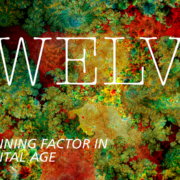- Brave New World: Three countries – three ways into the metaverse - 27. April 2023
- Speed is not an end in itself - 13. April 2023
- The gateway to the hybrid world - 12. July 2022
- So, what is a Client Service Director Asset Production doing? - 20. May 2022
- Our values are kind of guardrail in everyday business life - 11. May 2022
- In the Future, Stores Need to be More Than Just a Place for Transactions - 4. May 2022
- Be True To Yourself Throughout The Brand Experience - 27. April 2022
Organisations have come to realise that, in an age where everything is available to everyone, customer centricity is key and experience has become the X factor. The focus is on technology, with artificially intelligent algorithms and new interfaces to meet the needs of the customer. But how can we ensure that we don’t “just digitise” and that people and their needs remain in the foreground? An analysis by customer centricity and artificial intelligence expert Nancy Rademaker.
In our current digital world, keeping the human at the centre of everything is a big challenge for most organisations. Living up to the ever-increasing expectations of the customer is not always easy to do and will require continuous investments and adaptations. Even though technology can act as a huge enabler to deliver the utmost convenience, transparency and personalisation, how can we make sure we don’t “just digitalise”, but keep the true human connection as a priority?
Emotional Data
AI Technology that can recognise our human emotions and tailor the response accordingly.
The Ambiguity of Human Connection
There are two sides to this problem and they are related to the ambiguity within the notion of ‘human connection’. One aspect that defines us is that we always long for a strong connection with our fellow humans. We literally want to get in touch with others. We want to have physical conversations. The pandemic has of course reinforced this in a dramatic way. I like to refer to this as the ‘connection of the FEW’, the dialogues we have (mostly between two people) in which empathy, emotions and non-verbal signals play a crucial role. Next to this, we also long for connection in a broader sense. As humans, we have an intrinsic need for a sense of belonging. In the past this used to be local – our family, friends and peers – but with technology playing a much bigger role, it has evolved to a more regional, national or even global setting. One in which we are constantly looking for communities we can connect to and where we can converse with like-minded people. The nature of this ‘connection of the MANY’ is much more remote and its dynamics are very different from the first meaning.
Technology Enabling Human Connection?
How to deal with these two faces of connection as a retailer? How can technology help – if it can help at all? If we look at the connections of the many, these have of course been massively enabled through the social media platforms that have been on the rise for the past decade. According to Hootsuite, internet users worldwide spend around 2.5 hours on these social media (by the way, the West is lagging behind here!), and this number is rising every single month. Technology has enabled us all to influence and be influenced 24/7. We share our adventures, our purchases and our personal emotions with whomever wants to read them. Our social ‘status’ is determined by the number of views, shares and likes. The big platforms got us ‘hooked’ on this sense of belonging and brands are using it to the max to create tribes of followers to increase their brand reputation.
But will we settle JUST for the connection of the many? Of course not. We want to interact with individuals, and we want to be treated as individuals as well. As customers, whether it be in B2C or B2B, we value highly personalised interactions. In fact, we EXPECT highly personalised interactions. We no longer settle for some generic recommendation; we want it to be tailored to our exact personal needs and preferences. For most companies, this turned out to be quite a challenge, and fortunately technology has come to the rescue. Once all the relevant data – the absurdly BIG data – are collected, smart algorithms powered by artificial intelligence can accurately predict what we as customers want (even if we may not consciously be aware of it ourselves!). Knowing what your customer’s favourite channel is truly matters. Delivering seamless experiences ACROSS channels will soon matter even more.
Now the question arises, is all this ENOUGH to deliver a great customer experience? Is it enough to make it easy for me to buy stuff or make reservations online? Is it enough if the recommendations consider all my personal data and behaviours? Isn’t the essence of our human ‘being’ that we are emotional beings? Could it be that technology can NOT personalise our experiences enough, because it is unable to take our current emotions into account as well?
The Next Frontier
This is where emotional AI comes in: AI technology that can recognise our human emotions and tailor the response accordingly. Leveraging our ‘emotional data’ will have increasing priority for many companies. Amazon, for instance, introduced the Halo, a new wearable device that constantly monitors your tone of voice to detect your emotional state. Amazon claims this is to track your health and wellness, but just imagine the wealth of data they acquire in this way.
But there are more elements than just our voice. Parallel Dots has developed technology to help detect sentiment or emotion in written text, which can be used to make written responses more accurate. Companies like Intraface and Affectiva can analyse facial expressions to detect people’s emotional reactions in real time, which can for instance help to determine how they react to specific scenes in movies or TV shows and where to put certain ads. The Affectiva technology is also being used in cars, with numerous applications to augment in-vehicle experiences. Just imagine the climate, scent, light or music in your car being adapted to your mood…
Many hurdles will have to be overcome for emotional data to be handled correctly. Not only are they more intangible and sensitive than our ‘regular’ personal data, but we will also need to consider cultural differences in expressing emotions, multiple reactions at once (e.g. with several passengers in a car), and external elements influencing people’s voices or face muscles. Until technology can solve the problem of human connection completely, especially in a one-on-one setting, we will remain in great need of human employees to take care of this. And to be truly honest, as a customer I am still very happy doing business with actual PEOPLE!
This artice first appeared in TWELVE, Serviceplan Group’s magazine for brands, media and communication. In the eighth issue, you will find further inspiring articles, essays and interviews by and with prominent guest authors and renowned experts centred around the magazine’s theme “A human-driven future: How humans are shaping the digital world of tomorrow”. The e-paper is available here.








